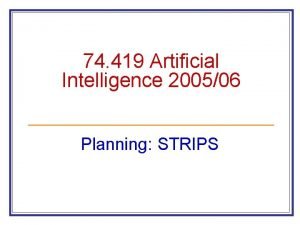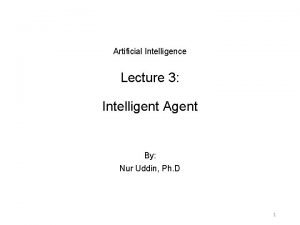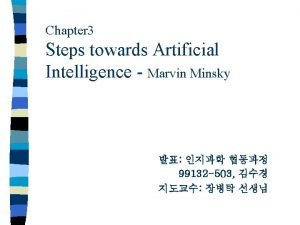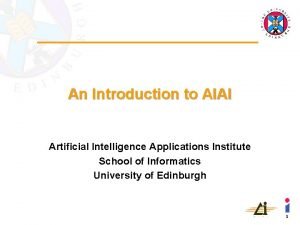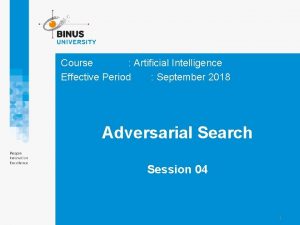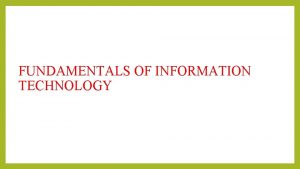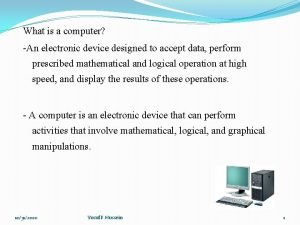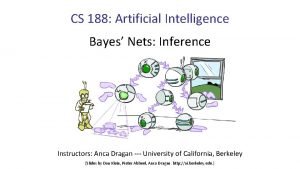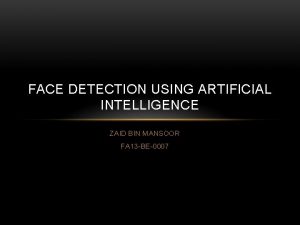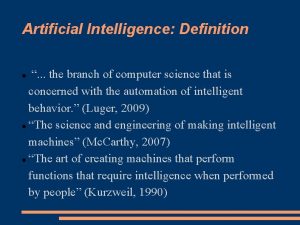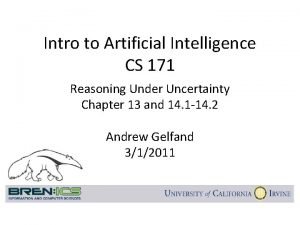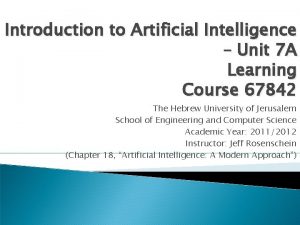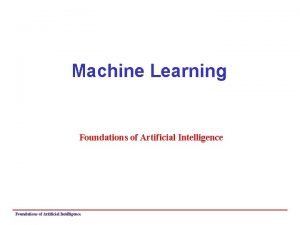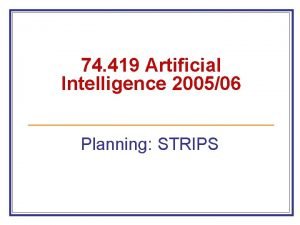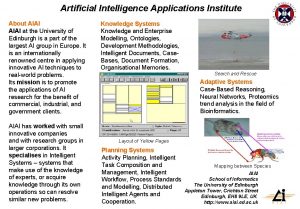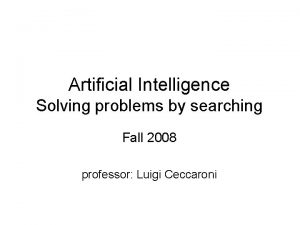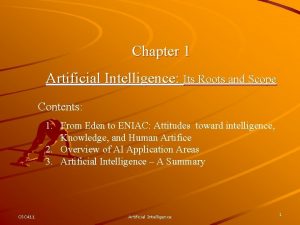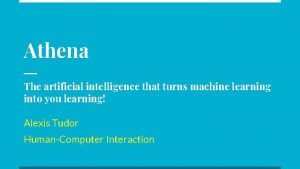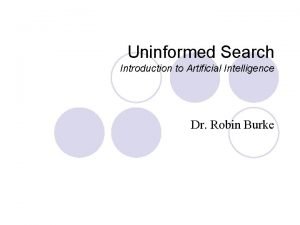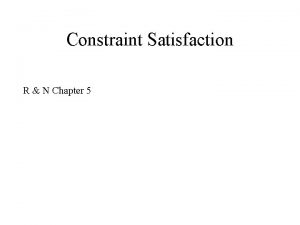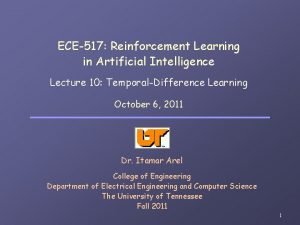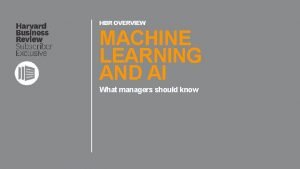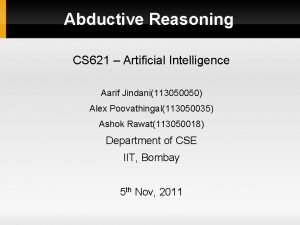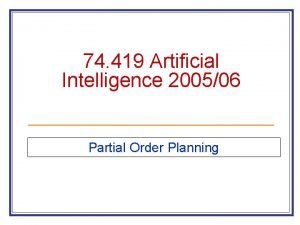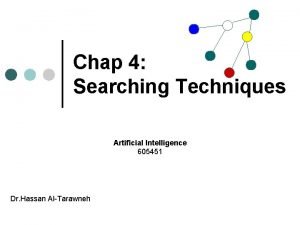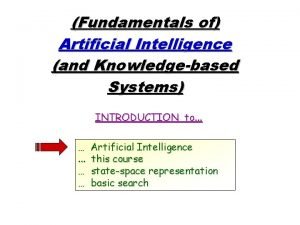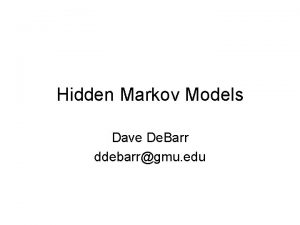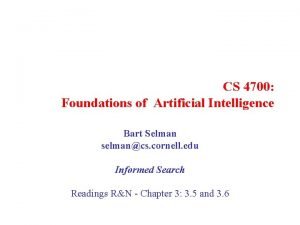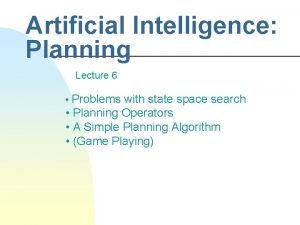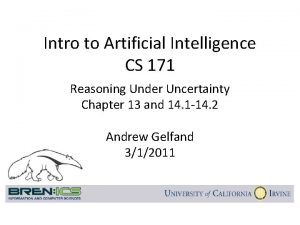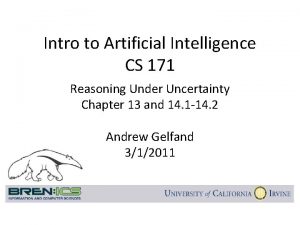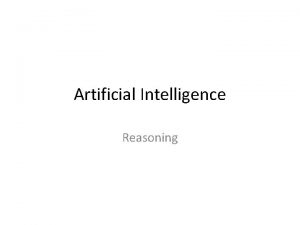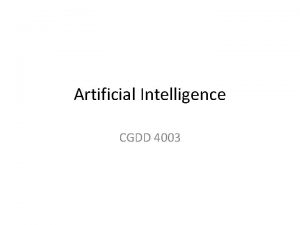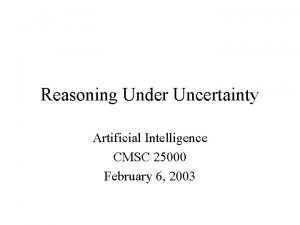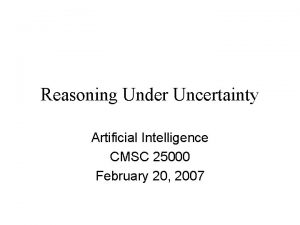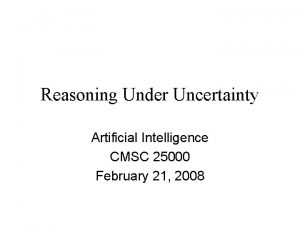Intro to Artificial Intelligence CS 171 Reasoning Under



























































- Slides: 59

Intro to Artificial Intelligence CS 171 Reasoning Under Uncertainty Chapter 13 and 14. 1 -14. 2 Andrew Gelfand 3/1/2011

Today… q Representing uncertainty is useful in knowledge bases o Probability provides a coherent framework for uncertainty q Review basic concepts in probability o Emphasis on conditional probability and conditional independence q Full joint distributions are difficult to work with o Conditional independence assumptions allow us to model real-world phenomena with much simpler models q Bayesian networks are a systematic way to build compact, structured distributions q Reading: Chapter 13; Chapter 14. 1 -14. 2

History of Probability in AI q Early AI (1950’s and 1960’s) o Attempts to solve AI problems using probability met with mixed success q Logical AI (1970’s, 80’s) o Recognized that working with full probability models is intractable o Abandoned probabilistic approaches o Focused on logic-based representations q Probabilistic AI (1990’s-present) o Judea Pearl invents Bayesian networks in 1988 o Realization that working w/ approximate probability models is tractable and useful o Development of machine learning techniques to learn such models from data o Probabilistic techniques now widely used in vision, speech recognition, robotics, language modeling, game-playing, etc.

Uncertainty Let action At = leave for airport t minutes before flight Will At get me there on time? Problems: 1. 2. 3. 4. partial observability (road state, other drivers' plans, etc. ) noisy sensors (traffic reports) uncertainty in action outcomes (flat tire, etc. ) immense complexity of modeling and predicting traffic Hence a purely logical approach either 1. 2. risks falsehood: “A 25 will get me there on time”, or leads to conclusions that are too weak for decision making: “A 25 will get me there on time if there's no accident on the bridge and it doesn't rain and my tires remain intact etc. ” (A 1440 might reasonably be said to get me there on time but I'd have to stay overnight in the airport …)

Handling uncertainty q Default or nonmonotonic logic: o o Assume my car does not have a flat tire Assume A 25 works unless contradicted by evidence q Issues: What assumptions are reasonable? How to handle contradiction? q Rules with fudge factors: o o o A 25 |→ 0. 3 get there on time Sprinkler |→ 0. 99 Wet. Grass |→ 0. 7 Rain q Issues: Problems with combination, e. g. , Sprinkler causes Rain? ? q Probability o o o Model agent's degree of belief Given the available evidence, A 25 will get me there on time with probability 0. 04

Probability Probabilistic assertions summarize effects of o laziness: failure to enumerate exceptions, qualifications, etc. o ignorance: lack of relevant facts, initial conditions, etc. Subjective probability: q Probabilities relate propositions to agent's own state of knowledge e. g. , P(A 25 | no reported accidents) = 0. 06 These are not assertions about the world Probabilities of propositions change with new evidence: e. g. , P(A 25 | no reported accidents, 5 a. m. ) = 0. 15

Making decisions under uncertainty Suppose I believe the following: P(A 25 gets me there on time | …) = 0. 04 P(A 90 gets me there on time | …) = 0. 70 P(A 120 gets me there on time | …) = 0. 95 P(A 1440 gets me there on time | …) = 0. 9999 q Which action to choose? Depends on my preferences for missing flight vs. time spent waiting, etc. o o Utility theory is used to represent and infer preferences Decision theory = probability theory + utility theory

Syntax q Basic element: random variable q Similar to propositional logic: possible worlds defined by assignment of values to random variables. q Boolean random variables e. g. , Cavity (do I have a cavity? ) q Discrete random variables e. g. , Dice is one of <1, 2, 3, 4, 5, 6> q Domain values must be exhaustive and mutually exclusive q Elementary proposition constructed by assignment of a value to a random variable: e. g. , Weather = sunny, Cavity = false (abbreviated as cavity) q Complex propositions formed from elementary propositions and standard logical connectives e. g. , Weather = sunny Cavity = false

Syntax q Atomic event: A complete specification of the state of the world about which the agent is uncertain q e. g. Imagine flipping two coins o The set of all possible worlds is: S={(H, H), (H, T), (T, H), (T, T)} Meaning there are 4 distinct atomic events in this world q Atomic events are mutually exclusive and exhaustive

Axioms of probability q Given a set of possible worlds S o P(A) ≥ 0 for all atomic events A o P(S) = 1 o If A and B are mutually exclusive, then: P(A B) = P(A) + P(B) q Refer to P(A) as probability of event A o e. g. if coins are fair P({H, H}) = ¼

Probability and Logic q Probability can be viewed as a generalization of propositional logic q P(a): o a is any sentence in propositional logic o Belief of agent in a is no longer restricted to true, false, unknown o P(a) can range from 0 to 1 § P(a) = 0, and P(a) = 1 are special cases § So logic can be viewed as a special case of probability

Basic Probability Theory q General case for A, B: P(A B) = P(A) + P(B) – P(A B) q e. g. , imagine I flip two coins o o Events {(H, H), (H, T), (T, H), (T, T)} are all equally likely Consider event E that the 1 st coin is heads: E={(H, H), (H, T)} And event F that the 2 nd coin is heads: F={(H, H), (T, H)} P(E F) = P(E) + P(F) – P(E F) = ½ + ½ - ¼ = ¾

Conditional Probability q The 2 dice problem o Suppose I roll two fair dice and 1 st dice is a 4 o What is probability that sum of the two dice is 6? o 6 possible events, given 1 st dice is 4 § (4, 1), (4, 2), (4, 3), (4, 4), (4, 5), (4, 6) o Since all events (originally) had same probability, these 6 events should have equal probability too o Probability is thus 1/6

Conditional Probability q Let A denote event that sum of dice is 6 q Let B denote event that 1 st dice is 4 q Conditional Probability denoted as: P(A|B) o Probability of event A given event B q General formula given by: o Probability of A B relative to probability of B q What is P(sum of dice = 3 | 1 st dice is 4)? o Let C denote event that sum of dice is 3 o P(B) is same, but P(C B) = 0

Random Variables q Often interested in some function of events, rather than the actual event o Care that sum of two dice is 4, not that the event was (1, 3), (2, 2) or (3, 1) q Random Variable is a real-valued function on space of all possible worlds o e. g. let Y = Number of heads in 2 coin flips § P(Y=0) = P({T, T}) = ¼ § P(Y=1) = P({H, T} {T, H}) = ½

Prior (Unconditional) Probability q Probability distribution gives values for all possible assignments: P(Weather) Sunny Rainy Cloudy Snowy 0. 7 0. 19 0. 01 q Joint probability distribution for a set of random variables gives the probability of every atomic event on those random variables P(Weather, Cavity) Sunny Rainy Cloudy Snowy Cavity 0. 144 0. 02 0. 016 0. 006 ⌐Cavity 0. 556 0. 08 0. 174 0. 004 q P(A, B) is shorthand for P(A B) q Joint distributions are normalized: Sa Sb P(A=a, B=b) = 1

Computing Probabilities q Say we are given following joint distribution: Joint distribution for k binary variables has 2 k probabilities!

Computing Probabilities q Say we are given following joint distribution: q What is P(cavity)? q Law of Total Probability (aka marginalization) P(a) = Sb P(a, b) = Sb P(a | b) P(b)

Computing Probabilities q What is P(cavity|toothache)? q Can get any conditional probability from joint distribution

Computing Probabilities: Normalization q What is P(Cavity|Toothache=toothache)? This is a distribution over the 2 states: {cavity, ¬cavity} Distributions will be denoted w/ capital letters; Probabilities will be denoted w/ lowercase letters. αP(Cavity, toothache) P(Cavity|toothache) Cavity = cavity 0. 108 + 0. 012 0. 6 = 0. 12 Cavity = ¬cavity 0. 016 + 0. 064 0. 4 = 0. 08

Computing Probabilities: The Chain Rule q We can always write P(a, b, c, … z) = P(a | b, c, …. z) P(b, c, … z) (by definition of joint probability) q Repeatedly applying this idea, we can write P(a, b, c, … z) = P(a | b, c, …. z) P(b | c, . . z) P(c|. . z). . P(z) q Semantically different factorizations w/ different orderings P(a, b, c, … z) = P(z | y, x, …. a) P(y | x, . . a) P(x|. . a). . P(a)

Independence q A and B are independent iff P(A|B) = P(A) or equivalently, P(B|A) = P(B) or equivalently, P(A, B) = P(A) P(B) “Whether B happens, does not affect how often A happens” q e. g. , for n independent biased coins, O(2 n) →O(n) q Absolute independence is powerful but rare q e. g. , consider field of dentistry. Many variables, none of which are independent. What should we do?

Conditional independence q P(Toothache, Cavity, Catch) has 23 – 1 = 7 independent entries q If I have a cavity, the probability that the probe catches doesn't depend on whether I have a toothache: (1) P(Catch | Toothache, cavity) = P(Catch | cavity) q The same independence holds if I haven't got a cavity: (2) P(Catch | Toothache, cavity) = P(Catch | cavity) q Catch is conditionally independent of Toothache given Cavity: P(Catch | Toothache, Cavity) = P(Catch | Cavity) q Equivalent statements: P(Toothache | Catch, Cavity) = P(Toothache | Cavity) P(Toothache, Catch | Cavity) = P(Toothache | Cavity) P(Catch | Cavity)

Conditional independence. . . q Write out full joint distribution using chain rule: P(Toothache, Catch, Cavity) = P(Toothache | Catch, Cavity) P(Catch | Cavity) P(Cavity) = P(Toothache | Cavity) P(Catch | Cavity) P(Toothache|Cavity) toothache ¬toothache P(Catch|Cavity) catch ¬catch P(Cavity) Cavity = cavity 0. 8 0. 2 Cavity = cavity 0. 7 0. 3 Cavity = cavity 0. 55 Cavity = ¬cavity 0. 4 0. 6 Cavity = ¬cavity 0. 5 Cavity = ¬cavity 0. 45 P(toothache, catch, ¬cavity) = ? ? = 0. 4 ∙ 0. 5 ∙ 0. 45 = 0. 09

Conditional independence. . . q Write out full joint distribution using chain rule: P(Toothache, Catch, Cavity) = P(Toothache | Catch, Cavity) P(Catch | Cavity) P(Cavity) = P(Toothache | Cavity) P(Catch | Cavity) P(Toothache|Cavity) toothache ¬toothache P(Catch|Cavity) catch ¬catch P(Cavity) Cavity = cavity 0. 8 0. 2 Cavity = cavity 0. 7 0. 3 Cavity = cavity 0. 55 Cavity = ¬cavity 0. 4 0. 6 Cavity = ¬cavity 0. 5 Cavity = ¬cavity 0. 45 Requires only 2 + 1 = 5 parameters! Use of conditional independence can reduce size of representation of the joint distribution from exponential in n to linear in n. Conditional independence is our most basic and robust form of knowledge about uncertain environments.

Conditional Independence vs Independence q Conditional independence does not imply independence q Example: o A = height o B = reading ability o C = age o P(reading ability | age, height) = P(reading ability | age) o P(height | reading ability, age) = P(height | age) q Note: o Height and reading ability are dependent (not independent) but are conditionally independent given age

Bayes’ Rule q Two jug problem o Jug 1 contains: 2 white balls & 7 black balls o Jug 2 contains: 5 white balls & 6 black balls o Flip a fair coin and draw a ball from Jug 1 if heads; Jug 2 if tails q What is probability that coin was heads, given a white ball was selected? o Want to compute P(H|W) o Have P(H) = P(T) = ½ , P(W|H) = 2/9 and P(W|T) = 5/11

Bayes' Rule… q Derived from product rule: P(a b) = P(a|b) P(b) = P(b|a) P(a) P(a | b) = P(b | a) P(a) / P(b) q or in distribution form P(Y|X) = P(X|Y) P(Y) / P(X) = αP(X|Y) P(Y) = αP(X, Y) q Useful for assessing diagnostic probability from causal probability: o o e. g. , let M be meningitis, S be stiff neck: P(m|s) = P(s|m) P(m) / P(s) = 0. 8 × 0. 0001 / 0. 1 = 0. 0008 o Note: posterior probability of meningitis still very small!

Bayes' Rule… q P(a | b, c) = ? ? = P(b, c | a) P(a) / P(b, c) q P(a, b | c, d) = ? ? = P(c, d | a, b) P(a, b) / P(c, d) Both are examples of basic pattern p(x|y) = p(y|x)p(x)/p(y) (it helps to group variables together, e. g. , y = (a, b), x = (c, d))

Decision Theory – why probabilities are useful q Consider 2 possible actions that can be recommended by a medical decision-making system: o a = operate o b = don’t operate q 2 possible states of the world o c = patient has cancer, ¬c = patient doesn’t have cancer q Agent’s degree of belief in c is P(c), so P(¬c) = 1 - P(c) q Utility (to agent) associated with various outcomes: o Take action a and patient has cancer: utility = $30 k o Take action a and patient has no cancer: utility = -$50 k o Take action b and patient has cancer: utility = -$100 k o Take action b and patient has no cancer: utility = 0.

Maximizing expected utility q What action should the agent take? o Rational agent should maximize expected utility q Expected cost of actions: E[ utility(a) ] = 30 P(c) – 50 [1 - P(c) ] E[ utility(b) ] = -100 P(c) Break even point? 30 P(c) – 50 + 50 P(c) = -100 P(c) + 30 P(c) + 50 P(c) = 50 => P(c) = 50/180 ~ 0. 28 If P(c) > 0. 28, the optimal decision is to operate q Original theory from economics, cognitive science (1950’s) - But widely used in modern AI, e. g. , in robotics, vision, game-playing q Can only make optimal decisions if know the probabilities

What does all this have to do with AI? q q q Logic-based knowledge representation o Set of sentences in KB o Agent’s belief in any sentence is: true, false, or unknown In real-world problems there is uncertainty o P(snow in New York on January 1) is not 0 or 1 or unknown o P(pit in square 2, 2 | evidence so far) o Ignoring this uncertainty can lead to brittle systems and inefficient use of information Uncertainty is due to: o Things we did not measure (which is always the case) § o Imperfect knowledge § o E. g. , in economic forecasting P(symptom | disease) -> we are not 100% sure Noisy measurements § P(speed > 50 | sensor reading > 50) is not 1

Agents, Probabilities & Degrees of Belief q What we were taught in school (“frequentist” view) o P(a) represents frequency that event a will happen in repeated trials q Degree of belief o P(a) represents an agent’s degree of belief that event a is true o This is a more general view of probability § Agent’s probability is based on what information they have § E. g. , based on data or based on a theory q Examples: o a = “life exists on another planet” § What is P(a)? We will assign different probabilities o a = “Mitt Romney will be the next US president” § What is P(a)? q Probabilities can vary from agent to agent depending on their models of the world and how much data they have

More on Degrees of Belief q Our interpretation of P(a | e) is that it is an agent’s degree of belief in the proposition a, given evidence e o Note that proposition a is true or false in the real-world o P(a|e) reflects the agent’s uncertainty or ignorance q The degree of belief interpretation does not mean that we need new or different rules for working with probabilities o The same rules (Bayes rule, law of total probability, probabilities sum to 1) still apply – our interpretation is different

Constructing a Propositional Probabilistic Knowledge Base q Define all variables of interest: A, B, C, … Z q Define a joint probability table for P(A, B, C, … Z) o Given this table, we have seen how to compute the answer to a query, P(query | evidence), where query and evidence = any propositional sentence q 2 major problems: o Computation time: § § o Model specification § o P(a|b) requires summing out other variables in the model e. g. , O(m. K-1) with K variables Joint table has O(m. K) entries – where do all the numbers come from? These 2 problems effectively halted the use of probability in AI research from the 1960’s up until about 1990

Bayesian Networks

A Whodunit q You return home from a long day to find that your house guest has been murdered. o There are two culprits: 1) The Butler; and 2) The Cook o There are three possible weapons: 1) A knife; 2) A gun; and 3) A candlestick q Let’s use probabilistic reasoning to find out whodunit?

Representing the problem q There are 2 uncertain quantities o Culprit = {Butler, Cook} o Weapon = {Knife, Pistol, Candlestick} q What distributions should we use? o o o Butler is an upstanding guy Cook has a checkered past Butler keeps a pistol from his army days Cook has access to many kitchen knives The Butler is much older than the cook

Representing the problem… q What distributions should we use? o Butler is an upstanding guy o Cook has a checkered past P(Culprit) o Butler keeps a pistol from his army days o Cook has access to many kitchen knives o The Butler is much older than the cook P(weapon|Culprit=Butler) P(weapon|Culprit=Cook) Pistol Knife Candlestick 0. 7 0. 15 Pistol Knife Candlestick 0. 1 0. 6 0. 3 Butler Cook 0. 3 0. 7

Solving the Crime q If we observe that the murder weapon was a pistol, who is the most likely culprit? The Butler!

Your 1 st Bayesian Network Culprit Weapon q Each node represents a random variable q Arrows indicate cause-effect relationship q Shaded nodes represent observed variables q Whodunit model in “words”: o Culprit chooses a weapon; o You observe the weapon and infer the culprit

Bayesian Networks q Represent dependence/independence via a directed graph o o Nodes = random variables Edges = direct dependence q Structure of the graph Conditional independence relations q Recall the chain rule of repeated conditioning: The full joint distribution The graph-structured approximation q Requires that graph is acyclic (no directed cycles) q 2 components to a Bayesian network o o The graph structure (conditional independence assumptions) The numerical probabilities (for each variable given its parents)

Example of a simple Bayesian network B A p(A, B, C) = p(C|A, B)p(A|B)p(B) = p(C|A, B)p(A)p(B) C Probability model has simple factored form Directed edges => direct dependence Absence of an edge => conditional independence Also known as belief networks, graphical models, causal networks Other formulations, e. g. , undirected graphical models

Examples of 3 -way Bayesian Networks A B C Marginal Independence: p(A, B, C) = p(A) p(B) p(C)

Examples of 3 -way Bayesian Networks Conditionally independent effects: p(A, B, C) = p(B|A)p(C|A)p(A) B and C are conditionally independent Given A A B C e. g. , A is a disease, and we model B and C as conditionally independent symptoms given A e. g. A is culprit, B is murder weapon and C is fingerprints on door to the guest’s room

Examples of 3 -way Bayesian Networks A B Independent Causes: p(A, B, C) = p(C|A, B)p(A)p(B) C “Explaining away” effect: Given C, observing A makes B less likely e. g. , earthquake/burglary/alarm example A and B are (marginally) independent but become dependent once C is known

Examples of 3 -way Bayesian Networks A B C Markov chain dependence: p(A, B, C) = p(C|B) p(B|A)p(A) e. g. If Prof. Lathrop goes to party, then I might go to party. If I go to party, then my wife might go to party.

Bigger Example q Consider the following 5 binary variables: o B = a burglary occurs at your house o E = an earthquake occurs at your house o A = the alarm goes off o J = John calls to report the alarm o M = Mary calls to report the alarm q Sample Query: What is P(B|M, J) ? q Using full joint distribution to answer this question requires o 25 - 1= 31 parameters q Can we use prior domain knowledge to come up with a Bayesian network that requires fewer probabilities?

Constructing a Bayesian Network (1) q Order variables in terms of causality (may be a partial order) e. g. , {E, B} -> {A} -> {J, M} q P(J, M, A, E, B) = P(J, M | A, E, B) P(A| E, B) P(E, B) ≈ P(J, M | A) P(A| E, B) P(E) P(B) ≈ P(J | A) P(M | A) P(A| E, B) P(E) P(B) q These conditional independence assumptions are reflected in the graph structure of the Bayesian network

The Resulting Bayesian Network

Constructing this Bayesian Network (2) q P(J, M, A, E, B) = P(J|A) P(M|A) P(A|E, B) P(E) P(B) q There are 3 conditional probability tables to be determined: o P(J|A), P(M|A), P(A|E, B) o Requires 2 + 4 = 8 probabilities q And 2 marginal probabilities P(E), P(B) q 10 parameters in Bayesian Network; 31 parameters in joint distribution q Where do these probabilities come from? o Expert knowledge o From data (relative frequency estimates) see Sections 20. 1 & 20. 2 (optional)

Number of Probabilities in Bayes Nets q Consider n binary variables q Unconstrained joint distribution requires O(2 n) probabilities q If we have a Bayesian network, with a maximum of k parents for any node, then we need O(n 2 k) probabilities q Example o Full unconstrained joint distribution § o n = 30: need 109 probabilities for full joint distribution Bayesian network § n = 30, k = 4: need 480 probabilities

The Bayesian Network from a different Variable Ordering {M} -> {J} -> {A} -> {B} -> {E} P(J, M, A, E, B) = P(M) P(J|M) P(A|M, J) P(B|A) P(E|A, B)

Inference (Reasoning) in Bayes Nets Consider answering a query in a Bayesian Network Q = set of query variables e = evidence (set of instantiated variable-value pairs) Inference = computation of conditional distribution P(Q | e) Examples P(burglary | alarm) P(earthquake | John. Calls, Mary. Calls) Can we use structure of the Bayesian Network to answer queries efficiently? Answer = yes Generally speaking, complexity is inversely proportional to sparsity of graph

Inference by Variable Elimination q Say that query is P(B|j, m) o P(B|j, m) = P(B, j, m) / P(j, m) = α P(B, j, m) q Apply evidence to expression for joint distribution o P(j, m, A, E, B) = P(j|A)P(m|A)P(A|E, B)P(E)P(B) q Marginalize out A and E Distribution over variable B – i. e. over states {b, ¬b} Sum is over states of variable A – i. e. {a, ¬a}

Complexity of Bayes Net Inference q Assume the network is a polytree D o Only a single directed path between any 2 nodes q Complexity scales as O(n m. K+1) § n = number of variables A § m = arity of variables § K = maximum number of parents for any node B E C o Compare to O(mn-1) for brute-force method q If network is not a polytree? o Can cluster variables to render ‘new’ graph that is a tree o Complexity is then O(n m. W+1), where W = # variables in largest cluster

Naïve Bayes Model C X 1 X 2 X 3 Xn P(C | X 1, …Xn) = a P P(Xi | C) P (C) Features X are conditionally independent given the class variable C Widely used in machine learning e. g. , spam email classification: X’s = counts of words in emails Probabilities P(C) and P(Xi | C) can easily be estimated from labeled data

Hidden Markov Model (HMM) Y 1 Y 2 Y 3 Yn Observed --------------------------S 1 S 2 S 3 Sn Hidden Two key assumptions: 1. hidden state sequence is Markov 2. observation Yt is Conditionally Independent of all other variables given St Widely used in speech recognition, protein sequence models Since this is a Bayesian network polytree, inference is linear in n

Summary q Bayesian networks represent joint distributions using a graph q The graph encodes a set of conditional independence assumptions q Answering queries (i. e. inference) in a Bayesian network amounts to efficient computation of appropriate conditional probabilities q Probabilistic inference is intractable in the general case o Can be done in linear time for certain classes of Bayesian networks
 Abstrips
Abstrips Omniscience in artificial intelligence
Omniscience in artificial intelligence Artificial intelligence applications institute
Artificial intelligence applications institute Architecture of expert system
Architecture of expert system Steps toward artificial intelligence
Steps toward artificial intelligence Conceptual graph in artificial intelligence tutorial
Conceptual graph in artificial intelligence tutorial References for artificial intelligence
References for artificial intelligence Artificial intelligence applications institute
Artificial intelligence applications institute 15-780 graduate artificial intelligence
15-780 graduate artificial intelligence Optimal decisions in games in artificial intelligence
Optimal decisions in games in artificial intelligence Artificial intelligence devices
Artificial intelligence devices A* and ao*
A* and ao* Knowledge manipulation in ai
Knowledge manipulation in ai A programmable electronic device designed to accept data
A programmable electronic device designed to accept data Informed search and uninformed search in ai
Informed search and uninformed search in ai Problem solving by searching in artificial intelligence
Problem solving by searching in artificial intelligence Inference by enumeration in artificial intelligence
Inference by enumeration in artificial intelligence Conclusion of artificial intelligence
Conclusion of artificial intelligence Part picking robot peas
Part picking robot peas Artificial intelligence is a branch of computer science
Artificial intelligence is a branch of computer science Artificial intelligence devices
Artificial intelligence devices Optimal decisions in games in artificial intelligence
Optimal decisions in games in artificial intelligence Unit 7 artificial intelligence
Unit 7 artificial intelligence Learning in ai
Learning in ai Artificial intelligence assessment
Artificial intelligence assessment Strips planning
Strips planning Int 404
Int 404 Artificial intelligence applications institute
Artificial intelligence applications institute State space search ai
State space search ai Solving problems by searching artificial intelligence
Solving problems by searching artificial intelligence Artificial intelligence chapter 1
Artificial intelligence chapter 1 What is utility based agent
What is utility based agent Blind search
Blind search Propositional logic in ai ppt
Propositional logic in ai ppt Xkcd artificial intelligence
Xkcd artificial intelligence Athena artificial intelligence
Athena artificial intelligence Csc 450
Csc 450 Artificial intelligence thesis proposals
Artificial intelligence thesis proposals Types of knowledge in artificial intelligence
Types of knowledge in artificial intelligence Uninformed search in artificial intelligence
Uninformed search in artificial intelligence What is artificial intelligence class 6
What is artificial intelligence class 6 Artificial intelligence chapter 1
Artificial intelligence chapter 1 Waltz algorithm in artificial intelligence
Waltz algorithm in artificial intelligence Passive reinforcement learning in artificial intelligence
Passive reinforcement learning in artificial intelligence Artificial intelligence applications institute
Artificial intelligence applications institute Artificial intelligence devices
Artificial intelligence devices Math for artificial intelligence
Math for artificial intelligence Hbr machine learning
Hbr machine learning Cpsc 322 ubc
Cpsc 322 ubc Ucs
Ucs Artificial intelligence
Artificial intelligence Searching for solutions in artificial intelligence
Searching for solutions in artificial intelligence Partial order planning in artificial intelligence
Partial order planning in artificial intelligence Solving problems by searching artificial intelligence
Solving problems by searching artificial intelligence Searching techniques in artificial intelligence
Searching techniques in artificial intelligence Fundamentals of artificial intelligence
Fundamentals of artificial intelligence Artificial intelligence: a modern approach
Artificial intelligence: a modern approach 15-780 graduate artificial intelligence
15-780 graduate artificial intelligence Artificial intelligence
Artificial intelligence Planning in artificial intelligence
Planning in artificial intelligence
